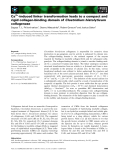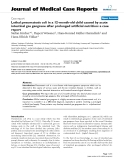
Gas gangrene
-
Clostridium histolyticum collagenase is responsible for extensive tissue destruction in gas gangrene, and its activity is enhanced by calcium ions. The collagen-binding domain is the minimal segment of the enzyme required for binding to insoluble collagen fibrils and for subsequent colla-genolysis.
 13p
13p  viettel02
viettel02
 22-02-2013
22-02-2013
 34
34
 3
3
 Download
Download
-
Tuyển tập báo cáo các nghiên cứu khoa học quốc tế ngành y học dành cho các bạn tham khảo đề tài: Lethal pneumatosis coli in a 12-month-old child caused by acute intestinal gas gangrene after prolonged artificial nutrition: a case report
 4p
4p  dauphong1
dauphong1
 21-12-2011
21-12-2011
 44
44
 4
4
 Download
Download
-
Diagnosis The diagnosis of clostridial disease, in association with positive cultures, must be based primarily on clinical findings. Because of the presence of clostridia in many wounds, their mere isolation from any site, including the blood, does not necessarily indicate severe disease. Smears of wound exudates, uterine scrapings, or cervical discharge may show abundant large gram-positive rods as well as other organisms. Cultures should be placed in selective media and incubated anaerobically for identification of clostridia.
 9p
9p  colgate_colgate
colgate_colgate
 21-12-2010
21-12-2010
 62
62
 4
4
 Download
Download
-
Gas Gangrene (Clostridial Myonecrosis) Gas gangrene is characterized by rapid and extensive necrosis of muscle accompanied by gas formation and systemic toxicity and occurs when bacteria invade healthy muscle from adjacent traumatized muscle or soft tissue. The infection originates in a wound contaminated with clostridia. Although 30% of deep wounds are infected with clostridia, the incidence of clostridial myonecrosis is quite low. These infections occur in both military and civilian settings.
 6p
6p  colgate_colgate
colgate_colgate
 21-12-2010
21-12-2010
 73
73
 3
3
 Download
Download
-
Clinical Manifestations Intestinal Disorders Food Poisoning C. perfringens, primarily type A, is the second or third most common cause of food poisoning in the United States (Chap. 122). The responsible toxin is thought to be a cytotoxin produced by 75% of strains isolated from cases of foodborne disease. The cytotoxin binds to a receptor on the small-bowel brush border and induces a calcium ion–dependent alteration in permeability. The associated loss of ions alters intracellular metabolism, resulting in cell death.
 7p
7p  colgate_colgate
colgate_colgate
 21-12-2010
21-12-2010
 68
68
 5
5
 Download
Download
-
Harrison's Internal Medicine Chapter 135. Gas Gangrene and Other Clostridial Infections Definition Bacteria of the genus Clostridium are gram-positive, spore-forming, obligate anaerobes that are ubiquitous in nature. There are 60 recognized species of clostridia, many of which are generally considered saprophytic. Some of these species are pathogenic for humans and animals, particularly under conditions of lowered oxidation-reduction potential. Infections associated with these organisms range from localized wound contamination to overwhelming systemic disease.
 5p
5p  colgate_colgate
colgate_colgate
 21-12-2010
21-12-2010
 79
79
 4
4
 Download
Download
-
Spontaneous nontraumatic clostridial myonecrosis (gas gangrene). A man in his 50s presented with severe pain in the right upper extremity. Over several hours, he developed progressive swelling and discoloration in that extremity (A), with hemorrhagic ecchymoses and bullae (B). Gram's stain of aspirate from bullous lesions revealed gram-positive bacilli (C). The patient underwent amputation of the extremity. Tissue Gram's stain (D) also showed gram-positive bacilli, and surgical cultures grew C. septicum.
 5p
5p  colgate_colgate
colgate_colgate
 21-12-2010
21-12-2010
 71
71
 3
3
 Download
Download
CHỦ ĐỀ BẠN MUỐN TÌM



















